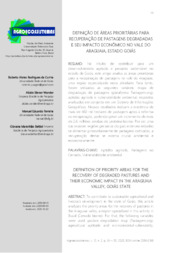Definição de áreas prioritária para recuperação de pastagens degradadas e seu impacto econômico no vale do Araguaia, Estado Goiás.
Definição de áreas prioritária para recuperação de pastagens degradadas e seu impacto econômico no vale do Araguaia, Estado Goiás.
Authorship: CUNHA, R. A. R. da; WANDER, A. E.; FERREIRA, M. E.; BETTIOL, G. M.
Summary: RESUMO: No intuito de contribuir para um desenvolvimento agrícola e pecuário sustentável no estado de Goiás, este artigo analisa as áreas prioritárias para a recuperação de pastagens no vale do Araguaia, uma região especializada nesta atividade. Para tanto, foram utilizadas as seguintes variáveis: mapa de degradação de pastagens (plataforma Pastagem.org), aptidão agrícola e vulnerabilidade ambiental, requisitos analisados em conjunto em um Sistema de Informações Geográficas. Nossos resultados indicam a existência de mais de 460 mil hectares de pastagem aptos à reforma ou recuperação, podendo gerar um incremento de mais de 2,6 milhões arrobas de proteína bovina. Por ser uma das maiores regiões pecuárias do país e de seu rebanho se alimentar primordialmente de pastagens cultivadas, a recuperação destas se mostra crucial ambiental e economicamente. DEFINITION OF PRIORITY AREAS FOR THE RECOVERY OF DEGRADED PASTURES AND THEIR ECONOMIC IMPACT IN THE ARAGUAIA VALLEY, GOIÁS STATE ABSTRACT: To contribute to sustainable agricultural and livestock development in the state of Goiás, this article analyzes the priority areas for the recovery of pastures in the Araguaia valley, a region specialized in this activity in Brazil (Cerrado biome). For that, the following variables were used: pasture degradation map (Pastagem.org), agricultural aptitude and environmental vulnerability,requirements analyzed together in a Geographic Information System. Our results indicate the existence of more than 460 thousand hectares of pasture suitable for reform or recovery, which may generate an increase of more than 2,6 million arrobas of bovine protein. As it is one of the largest livestock regions in the country and its herd feeds primarily on cultivated pastures, their recovery is crucial in environmental and economic terms.
Publication year: 2020
Types of publication: Journal article
Unit: Embrapa Rice & Beans
Keywords: Aptidão Agrícola, Cerrado, Pastagem, Vulnerabilidade ambiental
Observation
Some of Embrapa's publications are published as ePub files. To read them, use or download one of the following free software options to your computer or mobile device. Android: Google Play Books; IOS: iBooks; Windows and Linux: Calibre.
Access other publications
Access the Agricultural Research Database (BDPA) to consult Embrapa's full library collection and records.
Visit Embrapa Bookstore to purchase books and other publications sold by Embrapa.

